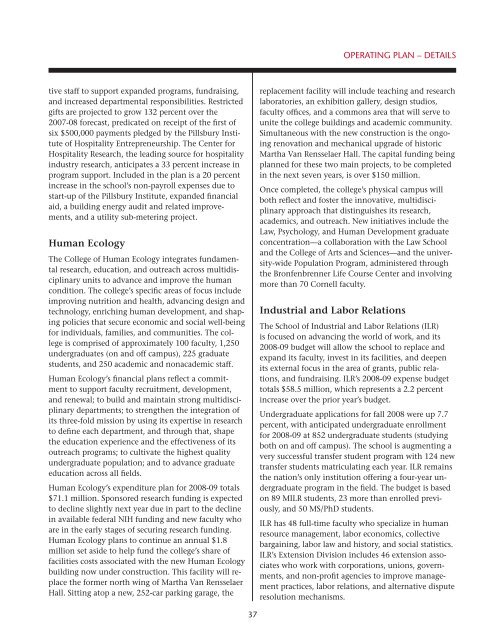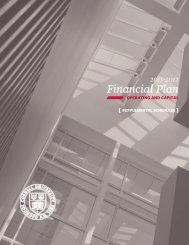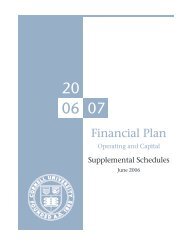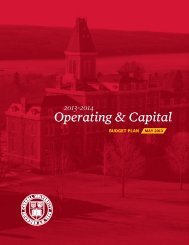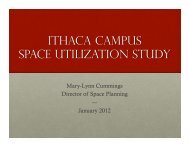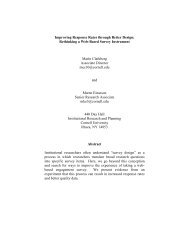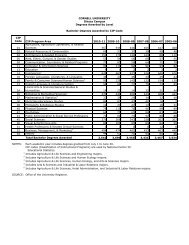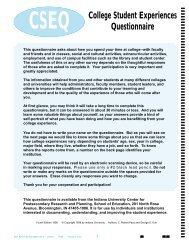Operating plan – DetailsThe 2008-09 budget includes the addition <strong>of</strong> two BMEfaculty, bringing the department’s total faculty to 12.BME plans to fill all 15 new faculty lines by 2010.In addition to BME hires, budgeted 2008-09 expendituresreflect four new faculty lines in the strategicgrowth areas <strong>of</strong> sustainable energy systems, computationalengineering, biomaterials, and nanoscience.These lines will be funded from reserves in advance <strong>of</strong>raising endowed pr<strong>of</strong>essorship funds.Engineering’s enrollment goals are tied implicitly tostrategic programmatic goals. The college is strivingto double its research funding over a ten-year period.A related goal is the plan to increase the number <strong>of</strong>Ph.D. students, with significant growth particularlyin the college’s six areas <strong>of</strong> strategic focus. Projected2008-09 expenses include newly funded Ph.D. fellowshipsand growth in sponsored research graduateassistantships. The new three-semester OperationsResearch in Manhattan M.Eng. degree program in financialengineering is projecting increased enrollmentin 2008-09. Students participate in internships andinstruction in Manhattan during their third semester.This year, the Systems Engineering M.Eng. degreewill <strong>of</strong>fer its first semester <strong>of</strong> a new industry-targeteddistance-learning degree program. Undergraduate enrollmentis projected to remain at the current level <strong>of</strong>approximately 3,000 students. New gifts and expendituresrelated to the college’s curriculum transformationand new Engineering Teaching Excellence Instituteand the allocation <strong>of</strong> resources to internationalprograms with India, China, Spain, and France arereflected in the 2008-09 budget.Engineering is one <strong>of</strong> the leaders in <strong>Cornell</strong>’s sustainabledevelopment initiative, with the college’s 2008-09financial plan reflecting a newly endowed Croll Pr<strong>of</strong>essor<strong>of</strong> Sustainable Energy Systems position, fundingfor graduate fellowships in sustainable energy systems,and development <strong>of</strong> curriculum and undergraduatestudent projects on energy and the environment.The college is implementing its facilities master plan,which is an extensive ten-year, multi-million dollarplan for new construction, renewal, and renovation<strong>of</strong> the college’s facilities. The 2008-09 budget reflectsimplementation <strong>of</strong> elements <strong>of</strong> the plan, including thesubstantial construction <strong>of</strong> the Olin Hall mechanicalinfrastructure, safety, and building exterior upgrade; afinalized bid for the design <strong>of</strong> a Phillips Hall laboratoryaddition and mechanical upgrades; and the completion<strong>of</strong> the feasibility study, site criteria selection, andconcept design for a new engineering building thatwill replace Carpenter Hall and most <strong>of</strong> Hollister Hall.Engineering’s 2008-09 plans include funding forthe Physical Sciences Building, which will provideimportant new space for the School <strong>of</strong> Applied andEngineering Physics. The college has also been planningfor the occupancy <strong>of</strong> the Weill Hall, which willcontain many <strong>of</strong> the faculty <strong>of</strong> the Biomedical EngineeringDepartment, as well as the design for GatesHall for the Department <strong>of</strong> Computer Science.Hotel AdministrationThe School <strong>of</strong> Hotel Administration is committedto remaining the number one school in hospitalityleadership education, and continues to focus on threegoals: (a) assuring that it remains the source for futureindustry leaders (which requires continuous improvement<strong>of</strong> undergraduate and graduate curriculums,specifically the quality <strong>of</strong> its students’ experientiallearning and international experience), (b) improvingits position as the source for industry knowledge andexpertise, and (c) creating an affordable educationaloption for an increasing global and diverse population<strong>of</strong> students. Consistent with those goals, during2008-09, the school will concentrate on (a) an undergraduatecurriculum review and development initiative,(b) a strategic review and development to evaluatethe feasibility and economics <strong>of</strong> building a muchlarger platform to extend its reach and influence, (c)an effort to capitalize on its global brand name andsecure the revenues needed to support its continuedgrowth and dominance within the hospitality industry,and (d) an implementation <strong>of</strong> energy conservationand sustainability initiatives for its facilities.The Hotel School consists <strong>of</strong> 71 faculty (including visitingand adjunct) and 22 other academic pr<strong>of</strong>essionalstaff dedicated to excellence in teaching, research andservice to an expected 2008-09 student enrollment <strong>of</strong>820 undergraduate students, 9 MS/PhD students, and60 Masters in Management in Hospitality students (40Ithaca and 20 Nanyang Technological <strong>University</strong>).The 2008-09 operating plan for the school is $48.7million. Salaries and wages are expected to increase11.3 percent due to the addition <strong>of</strong> four full-timefaculty as well as other pr<strong>of</strong>essional and administra-36
Operating plan – Detailstive staff to support expanded programs, fundraising,and increased departmental responsibilities. Restrictedgifts are projected to grow 132 percent over the2007-08 forecast, predicated on receipt <strong>of</strong> the first <strong>of</strong>six $500,000 payments pledged by the Pillsbury Institute<strong>of</strong> Hospitality Entrepreneurship. The Center forHospitality Research, the leading source for hospitalityindustry research, anticipates a 33 percent increase inprogram support. Included in the plan is a 20 percentincrease in the school’s non-payroll expenses due tostart-up <strong>of</strong> the Pillsbury Institute, expanded financialaid, a building energy audit and related improvements,and a utility sub-metering project.Human EcologyThe College <strong>of</strong> Human Ecology integrates fundamentalresearch, education, and outreach across multidisciplinaryunits to advance and improve the humancondition. The college’s specific areas <strong>of</strong> focus includeimproving nutrition and health, advancing design andtechnology, enriching human development, and shapingpolicies that secure economic and social well-beingfor individuals, families, and communities. The collegeis comprised <strong>of</strong> approximately 100 faculty, 1,250undergraduates (on and <strong>of</strong>f campus), 225 graduatestudents, and 250 academic and nonacademic staff.Human Ecology’s financial plans reflect a commitmentto support faculty recruitment, development,and renewal; to build and maintain strong multidisciplinarydepartments; to strengthen the integration <strong>of</strong>its three-fold mission by using its expertise in researchto define each department, and through that, shapethe education experience and the effectiveness <strong>of</strong> itsoutreach programs; to cultivate the highest qualityundergraduate population; and to advance graduateeducation across all fields.Human Ecology’s expenditure plan for 2008-09 totals$71.1 million. Sponsored research funding is expectedto decline slightly next year due in part to the declinein available federal NIH funding and new faculty whoare in the early stages <strong>of</strong> securing research funding.Human Ecology plans to continue an annual $1.8million set aside to help fund the college’s share <strong>of</strong>facilities costs associated with the new Human Ecologybuilding now under construction. This facility will replacethe former north wing <strong>of</strong> Martha Van RensselaerHall. Sitting atop a new, 252-car parking garage, thereplacement facility will include teaching and researchlaboratories, an exhibition gallery, design studios,faculty <strong>of</strong>fices, and a commons area that will serve tounite the college buildings and academic community.Simultaneous with the new construction is the ongoingrenovation and mechanical upgrade <strong>of</strong> historicMartha Van Rensselaer Hall. The capital funding beingplanned for these two main projects, to be completedin the next seven years, is over $150 million.Once completed, the college’s physical campus willboth reflect and foster the innovative, multidisciplinaryapproach that distinguishes its research,academics, and outreach. New initiatives include theLaw, Psychology, and Human Development graduateconcentration—a collaboration with the Law Schooland the College <strong>of</strong> Arts and Sciences—and the university-widePopulation Program, administered throughthe Bronfenbrenner Life Course Center and involvingmore than 70 <strong>Cornell</strong> faculty.Industrial and Labor RelationsThe School <strong>of</strong> Industrial and Labor Relations (ILR)is focused on advancing the world <strong>of</strong> work, and its2008-09 budget will allow the school to replace andexpand its faculty, invest in its facilities, and deepenits external focus in the area <strong>of</strong> grants, public relations,and fundraising. ILR’s 2008-09 expense budgettotals $58.5 million, which represents a 2.2 percentincrease over the prior year’s budget.Undergraduate applications for fall 2008 were up 7.7percent, with anticipated undergraduate enrollmentfor 2008-09 at 852 undergraduate students (studyingboth on and <strong>of</strong>f campus). The school is augmenting avery successful transfer student program with 124 newtransfer students matriculating each year. ILR remainsthe nation’s only institution <strong>of</strong>fering a four-year undergraduateprogram in the field. The budget is basedon 89 MILR students, 23 more than enrolled previously,and 50 MS/PhD students.ILR has 48 full-time faculty who specialize in humanresource management, labor economics, collectivebargaining, labor law and history, and social statistics.ILR’s Extension <strong>Division</strong> includes 46 extension associateswho work with corporations, unions, governments,and non-pr<strong>of</strong>it agencies to improve managementpractices, labor relations, and alternative disputeresolution mechanisms.37
- Page 5 and 6: Operating plan - highlightsIntroduc
- Page 8: Operating plan - highlightsComposit
- Page 11 and 12: Tuition, Financial Aid & Endowmentm
- Page 13 and 14: Tuition, Financial Aid & Endowmentu
- Page 15 and 16: Tuition, Financial Aid & EndowmentC
- Page 17 and 18: Tuition, Financial Aid & Endowmentf
- Page 19 and 20: Tuition, Financial Aid & EndowmentD
- Page 21 and 22: Tuition, Financial Aid & EndowmentC
- Page 23 and 24: Tuition, Financial Aid & EndowmentS
- Page 25 and 26: Tuition, Financial Aid & Endowmentw
- Page 27: Tuition, Financial Aid & Endowmentt
- Page 31 and 32: Tuition, Financial Aid & Endowmentp
- Page 33 and 34: Operating plan - DetailsIthaca Camp
- Page 35: Operating plan - DetailsSignificant
- Page 39 and 40: Operating plan - Detailsand develop
- Page 41 and 42: Operating plan - DetailsCentrallyOt
- Page 43 and 44: Operating plan - DetailsMedical Col
- Page 45 and 46: Capital PlanDistribution of Space -
- Page 47 and 48: Capital Plan• New York State supp
- Page 49 and 50: Capital PlanFUNDING SOURCESFINANCIN
- Page 51 and 52: Capital PlanEXPENDITURE PATTERNEsti
- Page 53 and 54: Capital PlanFUNDING SOURCESFINANCIN
- Page 55 and 56: Capital PlanEXPENDITURE PATTERNEsti
- Page 57 and 58: Capital PlanEXPENDITURE PATTERNEsti
- Page 59 and 60: Capital PlanDebt Service by Operati
- Page 61 and 62: BStudent Fees and Other Tuition Rat
- Page 63 and 64: DUndergraduate Tuition, Fees, Room,
- Page 65 and 66: FAverage Nine-Month Faculty Salarie
- Page 67 and 68: HNew York State AppropriationsSourc
- Page 69 and 70: JInvestment Assets, Returns, and Pa
- Page 71 and 72: LGifts/Contributions - Through Marc
- Page 73 and 74: NWorkforce - Ithaca Campus2007-08 I
- Page 75 and 76: PU.S. Senate ResponseThe Senate Com
- Page 77 and 78: U.S. Senate Response (continued)of
- Page 79 and 80: U.S. Senate Response (continued)inc
- Page 81 and 82: U.S. Senate Response (continued)fro
- Page 83 and 84: U.S. Senate Response (continued)Tab
- Page 85 and 86: U.S. Senate Response (continued)Tab
- Page 87 and 88:
U.S. Senate Response (continued)Tab


